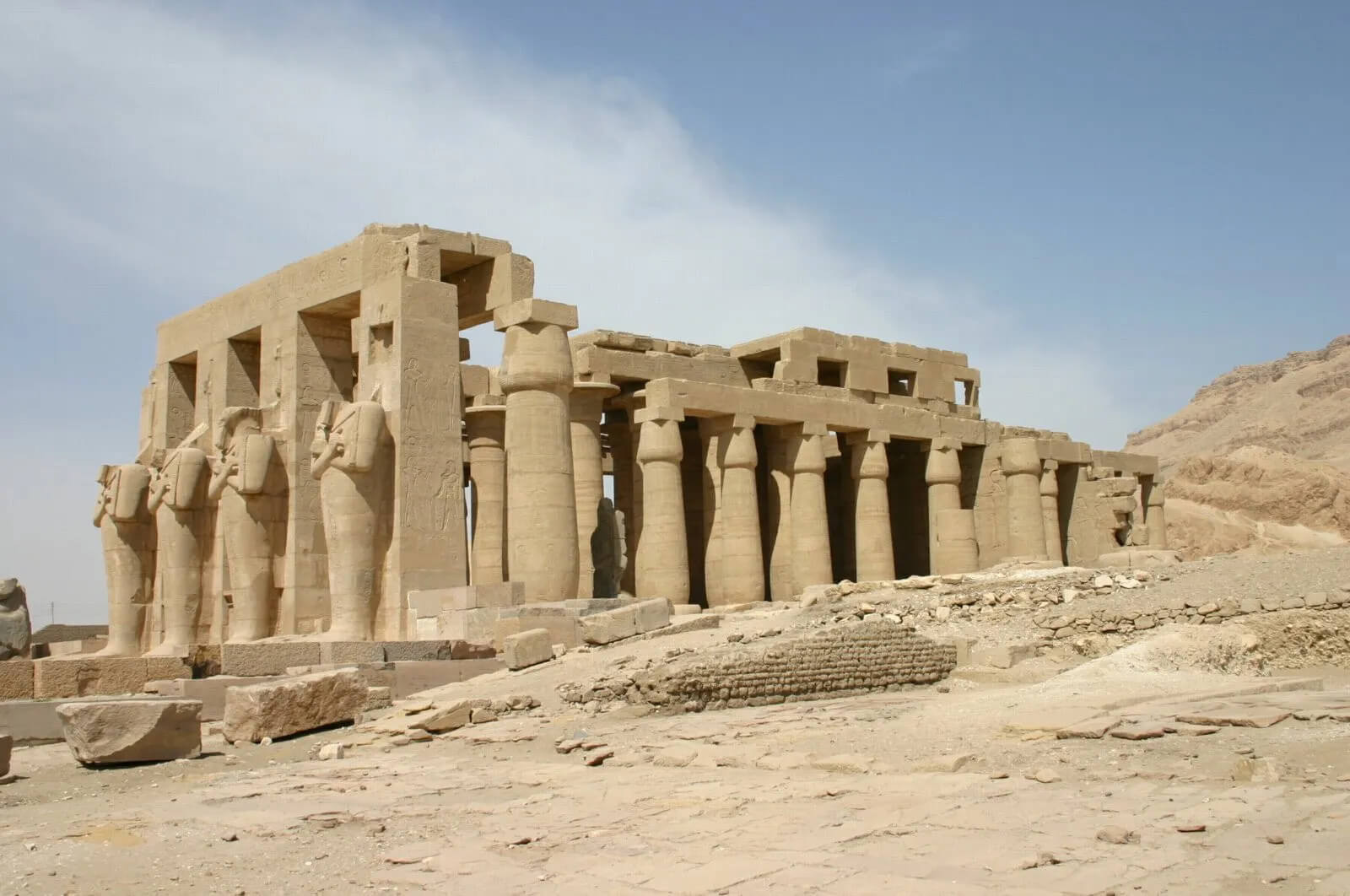| Rosette Rafaat | 2024-04-28 04:45:19 |
The Ramesseum Egypt is nestled on the fertile banks of the Nile River lies a testament to the grandeur and opulence of ancient Egyptian civilization. This magnificent archaeological site stands as a profound symbol of Pharaonic power and architectural prowess, drawing inquisitive minds from around the globe to unravel its mysteries.
In this exploration, we delve deep into the heart of Ramesseum Egypt, uncovering its captivating history, awe-inspiring architecture, and the enduring legacy it holds.
Ramesseum Egypt Facts: A Glimpse into History
The Ramesseum, also known as the Mortuary Temple of Ramses II, stands as a monumental tribute to the pharaoh Ramses II, one of ancient Egypt's most celebrated rulers. Located on the west bank of the Nile in Luxor, this sprawling complex was constructed during the 13th century BCE, during the height of the New Kingdom period.
When Was the Ramesseum Built?
Construction of the Ramesseum commenced in approximately 1279 BCE, under the reign of Ramses II, and it took several decades to complete. This majestic temple was dedicated to the worship of the god Amun, along with Ramses II himself, in a grand display of divine and royal authority.
Ramesseum Description: The Architecture and Design
The architectural brilliance of the Ramesseum leaves visitors in awe of its sheer scale and intricacy. The complex spans over 52,000 square meters and is surrounded by massive mudbrick enclosure walls, creating a sense of seclusion and sanctity.
At the heart of the Ramesseum lies the main temple, featuring a monumental pylon entrance adorned with colossal statues of Ramses II seated on his throne. Beyond the entrance, a vast courtyard opens up, flanked by towering columns adorned with intricate hieroglyphs and bas-reliefs depicting scenes from Ramses II's military conquests and religious ceremonies.
Ramesseum Statue: Icons of Ancient Majesty
One of the most striking features of the Ramesseum is its colossal statues, which once stood proudly within the temple grounds. Among these statues, the most renowned is the fallen colossus of Ramses II, which lies in shattered pieces, a poignant reminder of the passage of time and the eventual decline of even the mightiest monuments.
What Is the Ramesseum Made Of?
The Ramesseum was primarily constructed using sandstone blocks quarried from nearby sites, such as Gebel el-Silsila. These blocks were meticulously carved and assembled by skilled craftsmen to create the imposing structures that still command admiration today.
10 Facts about Ramesseum
The Ramesseum facts are:
-
The Ramesseum Egypt was not only a temple but also served as a mortuary complex, housing the tomb of Ramses II and other members of the royal family.
-
It is believed that the Ramesseum was the site of an annual festival known as the Opet Festival, during which the sacred barque of Amun would be carried in procession.
-
The temple complex underwent several additions and renovations by subsequent pharaohs, including Seti I and Merenptah, reflecting its continued importance throughout Egypt's history.
-
The Ramesseum is mentioned in Greek literature, most notably by the ancient historian Diodorus Siculus, who described it as "a building remarkable both for its size and beauty."
-
The site was extensively excavated and studied by renowned Egyptologists, including Jean-François Champollion and Howard Carter, who made significant contributions to our understanding of ancient Egyptian history.
-
The Ramesseum suffered extensive damage over the millennia, primarily due to natural erosion and human intervention, including quarrying and later reuse of its materials in other construction projects.
-
Despite its state of ruin, the Ramesseum continues to inspire awe and fascination among visitors, offering a glimpse into the grandeur of ancient Egyptian civilization.
-
The complex is surrounded by a vast necropolis containing the tombs of high-ranking officials and members of the royal court, reflecting the importance of the site as a center of religious and funerary rituals.
-
The Ramesseum was connected to the Karnak Temple complex in ancient times via a processional route known as the Avenue of Sphinxes, lined with sphinx statues depicting Ramses II.
-
Today, the Ramesseum is a popular tourist destination, offering visitors the opportunity to explore the remnants of this once-magnificent temple and contemplate the legacy of Ramses II and the ancient Egyptians.
What Is the Ramesseum Famous For?
The Ramesseum is famous for its colossal statues, intricate reliefs, and monumental architecture, which stand as enduring testaments to the power and grandeur of ancient Egypt. It is also renowned for its association with Ramses II, one of Egypt's most celebrated pharaohs, whose legacy continues to fascinate scholars and enthusiasts alike.
Ramesseum Egypt Tours: Exploring Ancient Majesty
For those eager to delve themselves into the splendor of ancient Egypt, Manta tours of the Ramesseum offer a captivating journey through time. Guided by knowledgeable Egyptologists, visitors can explore the temple complex, marvel at its architectural wonders, and gain insights into the religious beliefs and royal rituals of the pharaonic era.
Conclusion
In conclusion, the Ramesseum Egypt stands as a timeless monument to the ingenuity, artistry, and spiritual devotion of ancient Egypt. From its towering columns to its weathered statues, this majestic temple invites us to reflect on the enduring legacy of a civilization that continues to captivate and inspire the world.
FAQs
Why is the Ramesseum famous?
The Ramesseum is famous for its colossal statues, intricate reliefs, and monumental architecture, serving as a tribute to Pharaoh Ramses II and ancient Egyptian civilization.
Was Ramses in Egypt?
Yes, Ramses II ruled ancient Egypt during the 13th century BCE, overseeing the construction of monumental structures like the Ramesseum.
Is the Ramesseum still standing?
Yes, parts of the Ramesseum are still standing today, although it has suffered damage over time due to natural erosion and human intervention.
Did Ramses build the Ramesseum?
Ramses II commissioned the construction of the Ramesseum during his reign, dedicating it to the worship of the god Amun and as a mortuary temple for himself.
